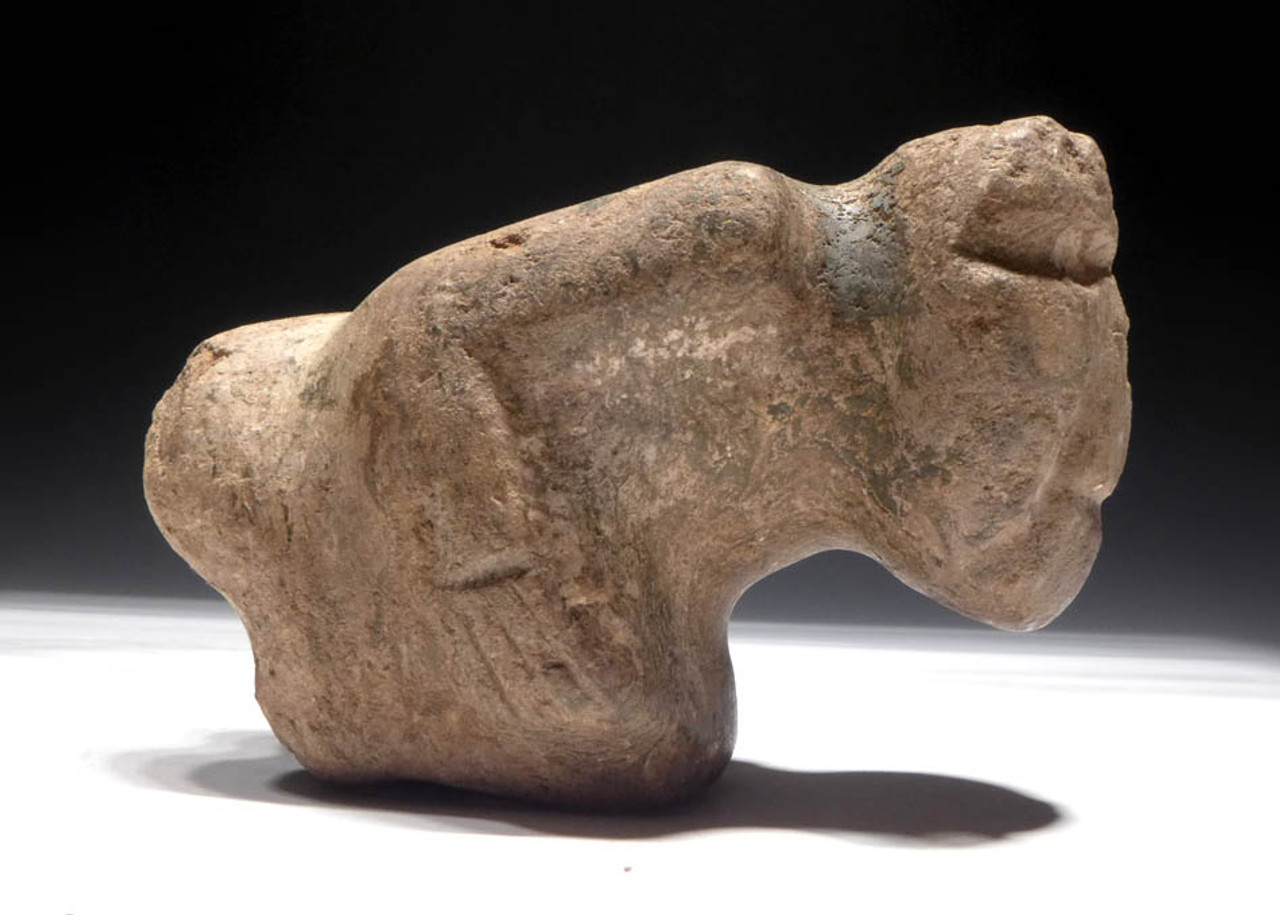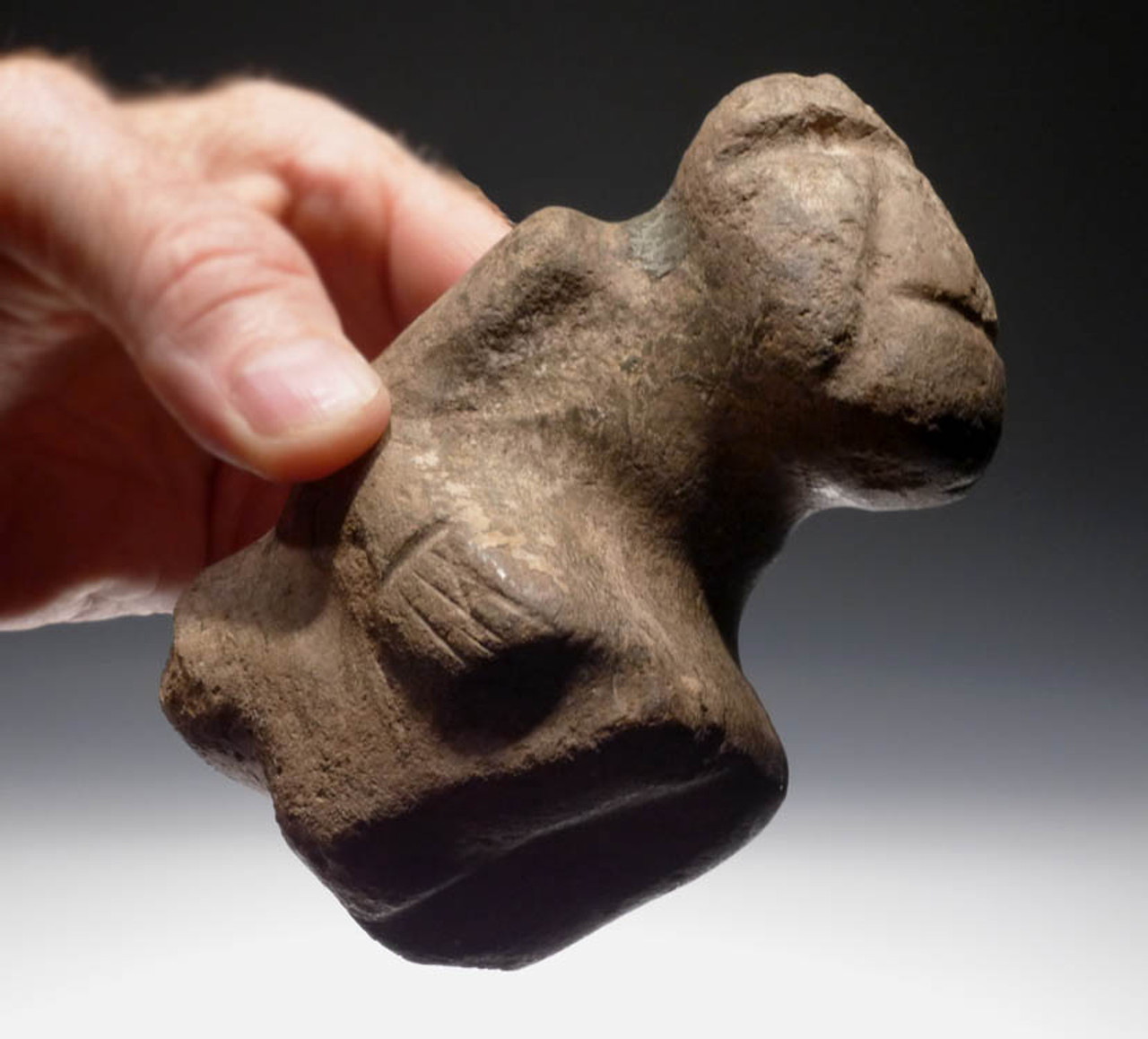Product Description
Carved human stone figures from Mezcala consistently bring five figure realized prices in major auctions around the globe. The cycladic art style of these RARE and highly sought after Pre-Columbian objects is unrivaled in Mesoamerican ancient art. Mezcala carved stone figures are so desirable and mysterious that even the later Pre-Columbian tribes of the region such as the inhabitants of Teotihuacan and the Aztecs, went to the trouble of digging them up and interring them into their own temples! The abstract artistic nature of these objects is so unusual and unique that immediately by sight alone, they are recognizable for their culture and region of origin! Presented here is one of the rarest forms - a crouching human figure of substantial size. Adding to the rarity of this object is the blatant evidence around his neck of formerly wearing a heavy copper or gold tumbaga neck ring, evidence by the layer of green copper patina on the stone surface in this area.
We have seen a few comparative examples like this Mezcala crouching stone figure but not many. It is carved in the typical style of Guerrero out of basalt. The figure is crouched with arms bent at the sides and hands down. The facial expression is additionally detailed with lines on the face. Most notable is the green patina around the neck indicating a copper or precious metal alloy ring was originally placed on the neck of this piece. This is the first instance we have seen irrefutable evidence that these objects were adorned with metal items. A ring around the neck of this figure could have represented a captive slave or a high nobleman with a necklace, kneeling in worship of a deity.
Carved stone Pre-Columbian objects are exceedingly more rare than ceramics due to the time and work involved in creating them compared to much easier manufactured ceramic pieces.
MEZCALA CARVED STONE FIGURES CONSISTENTLY FETCH 5 FIGURE PRICES IN MAJOR AUCTIONS DUE TO THEIR RARITY OF FORM AND ARTISTIC VALUE. EVEN SUBSEQUENT ANCIENT PRE-COLUMBIAN CULTURES OF THE REGION VALUED THESE OBJECTS, TO THE POINT OF EXCAVATING THEM AND INTERRING THEM IN THEIR OWN LATER PERIOD TEMPLES!!!
HISTORY
The Pre-Columbian Mezcala Culture is a little understood culture that was based in present-day Guerrero, Mexico. A long, complex culture history of the Guerrero region prevents a finite understanding of who exactly made Mezcala objects. The culture is also called Balsas Culture because it is centered in the upper Balsas River drainage region. It is believed the Mezcala style emerged during the Pre-classic Period, between 700-200 B.C. and continued on into Classic Period to 650 A.D..
Objects attributed to the the Mezcala Culture include figurines, masks, small effigies of animals and objects, beads, pendants and earplug flares. They are carved from a variety of green, gray-green, gray and black color hardstones and jade. The art style is so unique that Mezcala objects are readily recognized for their abstract and minimalist anatomical features. Some Mezcala style stone objects show strong Olmec influence. Beautiful stylized masks from Guerrero exhibit Teotihuacan Classic Period influence. Mezcala style objects were excavated by the much later Aztec peoples and revered as sacred objects.
Mezcala style stone carved figurines have a basic petaloid axe form and are sometimes casually labeled "axe gods". Symmetrically arranged cuts in the stone are arranged to resemble facial and body features. Scarcer objects depict human forms in seated or crouching positions. Carved stone masks are found in more diverse forms from abstract to beautifully stylized renderings. Clay figures and pottery are also known but the culture is most famous for its unique carved stone objects.
 US DOLLAR
US DOLLAR
 EURO
EURO
 AUSTRALIAN DOLLAR
AUSTRALIAN DOLLAR
 CANADIAN DOLLAR
CANADIAN DOLLAR
 POUND STERLING
POUND STERLING


















